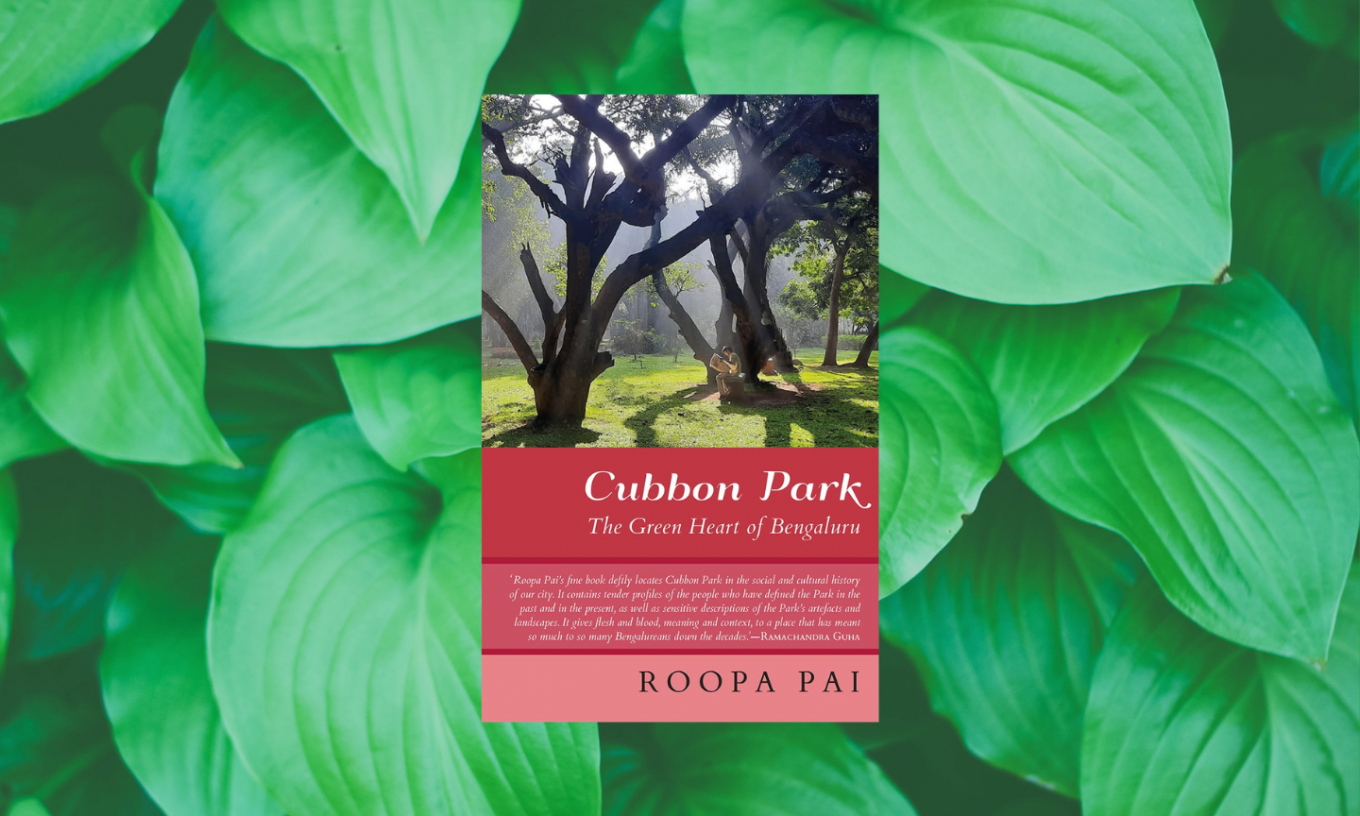Title: Cubbon Park – The Green Heart of Bengaluru
Author: Roopa Pai
Publisher: Speaking Tiger
Year of Publication: 2022
In Cubbon Park: The Green Heart of Bengaluru, the author, Roopa Pai, charts a course in history and geography as she navigates the readers through the making of the green sanctuary of Bengaluru. She deftly weaves in and out of the specifics of Cubbon Park itself as well as the people who have had a hand in its making. Enthralling and educational in the right mix, she details the various aspects which make Cubbon Park what it is: an integral part of Bengaluru.
***
“The land on which Cubbon Park lies was sacred to Bangaloreans for at least a century before Richard Sankey clapped eyes on it. A saltwater tank called Uppuneerina Kunte, located close to the south-eastern boundary of the Park, has been central to the eleven-day festival of Karaga, a fixture on the city’s annual calendar for over 250 years now. Dedicated to Draupadi, the feisty heroine of the Mahabharata, Karaga is essentially a festival that honours and celebrates water as Adi Shakti, the sacred feminine.”
***
Whenever I think of a park, the first thing that comes to mind is the Mumbai Port Trust Garden or Priyadarshini Park, two of the few green spaces in South Bombay. They serve as my go-to area when in need of respite from the wet heat of Mumbai or for quiet evenings away from the craziness that defines Mumbai. It’s a boon to have a green area in the midst of a city like Mumbai.
When I picked up Cubbon Park: The Green Heart of Bengaluru, I was in no way ready for a lesson in history from the perspective of a park that spans around 300 acres in the centre of the city. Those who have intimate knowledge of Mumbai and Bengaluru, know that the two cities are not very different when it comes to at least one aspect of the “craziness” (read traffic). Cubbon Park lies at the heart of Bengaluru and pulsates with the kind of life whose cycle runs in historical portions and is demarcated by dizzying fluctuations.
A case in point: The story behind the location of Bengaluru itself is just as delightful to read as the story behind the location of Cubbon Park. We go from how Kempegowda I, in 1537, decided to build his capital, which was the focal point around which present-day Bengaluru flourished; to the establishment of Cubbon Park, inaugurated in 1870, involving Assistant Chief Engineer Sankey, a twelve-year-old maharaja – Mummadi Krishnaraja Wadiyar, the death of Tipu Sultan, and Mark Cubbon himself. The arc spans an astounding 333 years. I have left out significant players that were involved in the making of Cubbon Park for reasons of verbosity.
The author weaves an academic and emotional tale where the protagonist is a force of nature. The sheer vicissitude of changes that the park has seen and endured is nothing short of sensational. It begins right from its conception, as seen above, and it goes on and on with respect to every building constructed within the compounds of the demarcated park area. Every brick, every shrub and every path is buried and dripping with history and stories of the past.
The park’s share in modern history isn’t free from being a singular spectacle either. Heartbroken folks of Bengaluru took to the streets as recently as 1998 to protest the de-notification of something between 32 and 44 acres of the park for redevelopment. The author, rightly so in my opinion, points out in the very beginning that the protest that lasted weeks failed. After all, it’s not an exercise in merrymaking, it’s the sentimentality of the people of Bengaluru, and one does not play around with sentimentality.
Cubbon Park is so closely tied in with the people of Bengaluru that it has evolved alongside the people that frequent it. It has been the haunt of lovers, of the health conscious, of music lovers and of bird-watchers, of dog walkers, of poets and it has even been a silent protector for someone who ‘almost’ lost her eyesight. The people of Bengaluru have nurtured this green area with the kind of love that can probably only be felt with what the park gives back in return.
Cubbon Park alters itself to suit the requirements of its regulars. It has been an iconic music strip for its musicians; a haven for butterflies (around 40 species), birds (around 63 species) and medicinal plants (around 110 species). It should be noted that this is from almost 25 years ago.
The story of the sprawling park arcs over its immediate vicinity, be it geographically or historically speaking. Its various buildings have a history of their own and the people involved with the building of Cubbon are also architects of Bengaluru in a manner of speaking. The original name, Chamarajendra Park, was based on Mummadi Krishnaraja Wadiyar’s grandson. Although the old name is proclaimed by the large welcome arches, it is the name of the park’s first commissioner, Mark Cubbon that has endured. Similarly, the Government Museum was curated by a Scottish, Edward Balfour. His uncle, Joseph Hume was a commissioned surgeon in the army and it was one of Hume’s sons, Allan Octavian Hume, who founded the Indian National Congress.
The history of Cubbon Park, as already mentioned, doesn’t only arc over its immediate vicinity. It strides across Europe and connects Asia via a Jew fleeing Nazi persecution.
Otto Koenigsberger, an architect, had the brilliance to create sustainable, climate-responsive architecture. He was initially hand-picked by Prime Minister Nehru to be the first Director of Housing for the Government of India. He was chosen because of his talent for using inexpensive innovation to create low-cost housing for the millions displaced by Partition. Bal Bhavan, initially called Victory Hall, was designed by Otto Koenigsberger. Interestingly, he was the nephew of Max Born, and it was he who suggested Otto Koenigsberger to Sir CV Raman when the latter asked him for a talented architect.
The author’s words do justice to the passion the Park holds in the eye of the people of Bengaluru. It is said that it’s difficult to not put a little of yourself in the words that one writes, and nowhere is it more clear when working on something as inalienable as a part of your childhood, and adult, experiences. Memories come alive; along with the memories come the sweet auditory enhancements characterising and livening up the experience.
Having been to Bengaluru just once over almost 15 years ago, Cubbon Park has become a beacon that lights my travel plans and beckons me over for a long overdue visit. I know with certainty that my next visit to Bengaluru will feature a long visit to the Park where I’ll savour the experience of associating the visual memories with landmarks etched via the book.
I won’t miss the traffic though.





